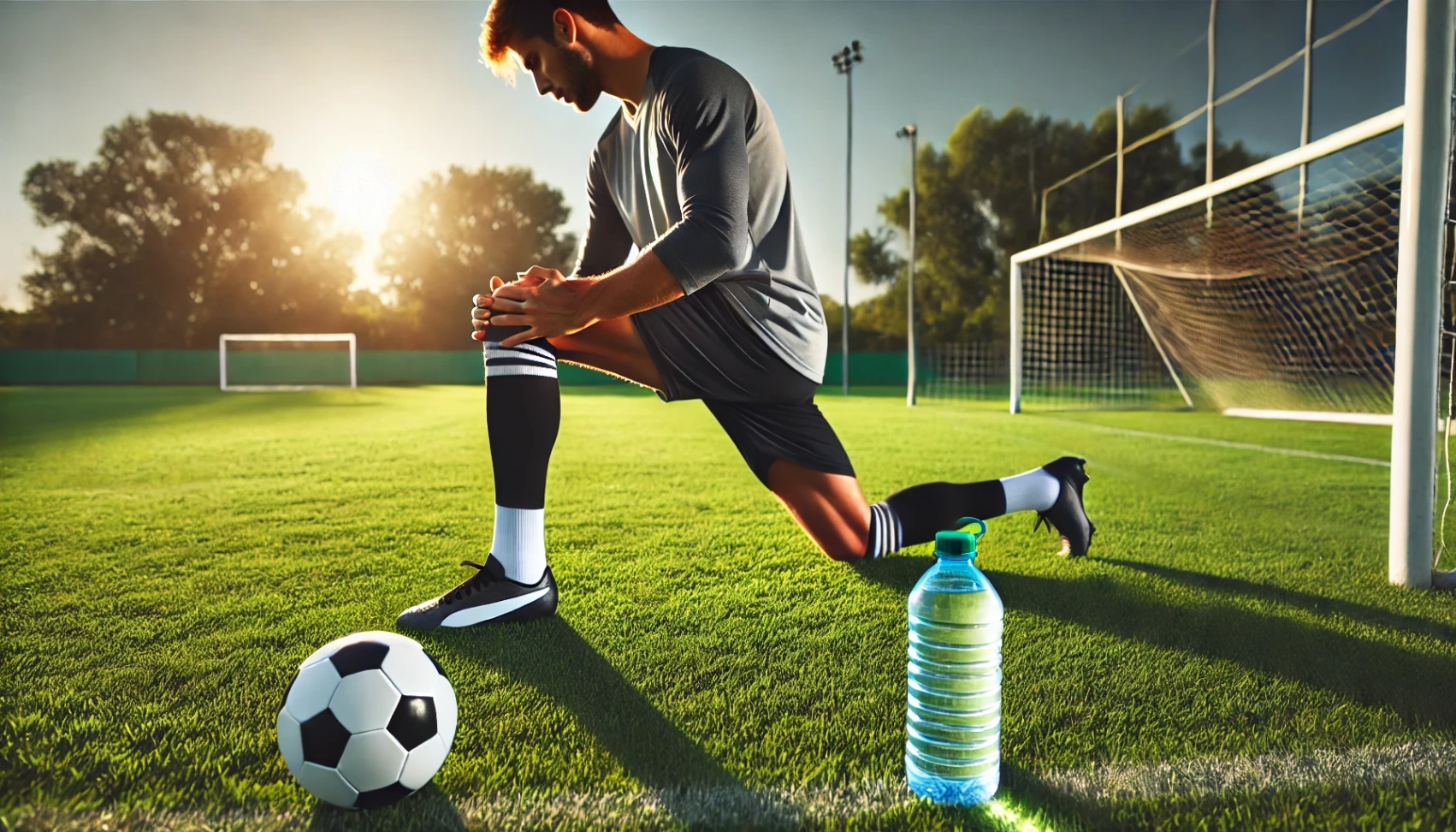
Soccer Warm-Up Routines are essential for avoiding injuries and performing at your best.
Properly preparing your body reduces the chance of injury and increases your agility on the field.
This guide covers effective Soccer Warm-Up Routines to prepare you to compete at your best.
Benefits of Warm-Up
Warming up before soccer is more than just a routine—it’s essential for safety and performance. Here are the key benefits of a proper warm-up:
- Reduces risk of injury: Prepares muscles and joints, minimizing strains and sprains.
- Increases flexibility and mobility: Loosens muscles for a better range of motion.
- Boosts agility and reaction time: Enhances quick movements and sharpens reflexes.
- Prepares muscles and joints for intense activity: Warms up your body to handle the demands of the game.
- Enhances mental focus and readiness: Sharpens concentration and gets you mentally prepared for the match.
- Improves overall performance on the field: Helps you start strong, stay consistent, and maintain energy.

Essential Components of a Soccer Warm-Up Routine
To get the most out of your soccer warm-up, it’s important to incorporate several additional elements.
Here’s a more detailed breakdown of the essential components:
- Cardio Warm-Up: Light jogging, skipping, or side shuffles to increase blood flow and heart rate.
- Dynamic Stretching: Include leg swings, lunges, high knees, butt kicks, and arm circles for improved flexibility.
- Ball Work: Dribbling, passing, and shooting to familiarize yourself with the ball and activate key muscles.
- Agility Drills: Quick sprints, ladder, and cone drills for better coordination and agility.
- Muscle Activation: Lunges, squats, and side steps to engage major muscle groups like quads, hamstrings, and calves.
- Mental Focus: Visualize game situations and get in the zone for mental sharpness.
- Reaction Training: Partner or solo drills to improve reaction time, such as quick changes in direction.
- Core Activation: Planks, side planks, or bridges to engage your core muscles.
- Stretching for Flexibility: Target specific muscle groups like hamstrings, quads, and hip flexors for injury prevention.
- Breathing Exercises: Controlled breathing to stabilize your heart rate and prepare for the game’s intensity.
Age-Specific Soccer Warm-Up Routines for Injury Prevention
Different age groups require specific warm-up routines for injury prevention and peak performance.
Here’s a breakdown of soccer warm-up routines tailored for each age group:
Young Children (5-10 years)
- Focus on fun, playful movements like running games.
- Simple dynamic stretches such as high knees and skipping.
- Short ball-handling drills to keep them engaged.
Pre-teens (11-13 years)
- Light jogging or brisk walking to raise the heart rate.
- Basic dynamic stretches like lunges and arm circles.
- Low-intensity ball work and agility drills for coordination.
Teenagers (14-17 years)
- Moderate cardio, such as jogging or shuttle runs.
- Full-body dynamic stretches, including leg swings and side lunges.
- Ball work with an emphasis on ball control and short sprints.
Adults (18-35 years)
- High-intensity cardio like running or interval sprints.
- Advanced dynamic stretches and mobility exercises.
- Position-specific ball work and reaction drills.
Older Adults (36+ years)
- Low-impact cardio, like brisk walking or cycling.
- Gentle dynamic stretches focusing on joint mobility.
- Slow, controlled ball work and light agility exercises.
How to Incorporate Resistance Bands into Soccer Warm-Ups
Resistance bands are a great way to enhance your soccer warm-up by activating key muscle groups and improving strength.
Here’s how to effectively incorporate resistance bands into your warm-up routine:
- Lateral Band Walks: Strengthens hip muscles and improves lateral movement.
- Glute Bridges with Band: Engages glutes and hamstrings for stability and power.
- Standing Leg Abductions: Targets hip abductors to improve balance and agility.
- Squats with Resistance Band: Activates leg muscles, especially quads and hamstrings.
- Ankle Band Drills: Improves foot speed and control by resisting ankle movements.
- Resistance Band Sprints: Adds resistance to your sprints for enhanced power and acceleration.
- Band-Resisted Lateral Shuffles: Builds lateral speed and coordination for quick changes in direction.
How to Adjust Your Warm-Up for Different Weather Conditions
Weather plays a significant role in how your body responds during a soccer warm-up. Adjusting your routine based on conditions can help prevent injuries and optimize performance. Here’s how to modify your warm-up for different weather scenarios:
Cold Weather:
- Start with a longer cardio warm-up to increase body temperature.
- Wear layers to keep muscles warm and prevent stiffness.
- Focus on dynamic stretches to promote blood flow.
- Incorporate more muscle activation exercises to avoid tightness.
Hot Weather:
- Shorten the cardio portion to avoid overheating.
- Stay hydrated and take breaks during warm-up.
- Use lighter, looser clothing for better air circulation.
- Include gentle dynamic stretching to prevent muscle fatigue.
Rainy Weather:
- Add extra balance and coordination drills to prevent slipping.
- Use waterproof gear and footwear for traction.
- Keep movements controlled to avoid sudden slips or falls.
- Focus on warming up joints and muscles, which may tighten in damp conditions.
Windy Weather:
- Prioritize muscle activation exercises to maintain body warmth.
- Use resistance bands to add stability to your warm-up routine.
- Include extra ball control drills to adjust to unpredictable wind conditions.
Humid Weather:
- Reduce intensity to avoid overheating.
- Stay hydrated before and during warm-up.
- Include longer recovery periods between exercises.
- Wear breathable, moisture-wicking clothing to stay cool.
How Warm-Up Routines Vary by Soccer Position
Each soccer position requires specific physical demands, so warm-up routines should be tailored accordingly.
Here’s how warm-ups vary by position to ensure players are prepared for the unique movements and challenges of their roles:
Goalkeepers:
- Focus on reaction drills and hand-eye coordination.
- Dynamic stretching for shoulders, arms, and core.
- Agility drills like lateral jumps to improve quick directional changes.
- Practice short sprints for explosive dives and saves.
Defenders:
- Emphasize strength and stability exercises for the core and legs.
- Include agility drills to prepare for quick turns and marking.
- Ball control and passing drills for precision in clearing the ball.
- Sprint works to handle quick offensive attacks.
Midfielders:
- Prioritize endurance and aerobic warm-up to handle constant movement.
- Dynamic stretches for full-body mobility.
- Ball control, passing, and dribbling drills to maintain possession.
- Include short sprints and agility drills for quick transitions.
Forwards/Strikers:
- Focus on explosive sprint drills for quick breaks toward a goal.
- Agility and directional change exercises to beat defenders.
- Ball control and shooting drills to fine-tune accuracy.
- Stretch hip flexors and quads for power in shots.
Wingers:
- Emphasize speed and agility work for sideline runs.
- Include long-distance sprint drills.
- Ball control and crossing practice for effective assists.
- Dynamic stretching to maintain flexibility for sharp turns.

The Importance of Hydration in Your Soccer Warm-Up Routine
Hydration is often overlooked but is crucial to an effective soccer warm-up routine.
Staying hydrated helps maintain energy levels, improves muscle function, and prevents fatigue or injury. Here’s why hydration is essential during your warm-up:
- Maintains Optimal Muscle Function: Proper hydration ensures muscles contract and relax efficiently.
- Prevents Early Fatigue: Drinking water keeps energy levels high and prevents early exhaustion.
- Regulates Body Temperature: Helps your body cool down as you warm up.
- Reduces Risk of Cramps: Hydrated muscles are less prone to painful cramps during intense activity.
- Enhances Mental Focus: Hydration improves concentration and reaction time.
- Aids in Recovery: Proper hydration during warm-up helps your body recover faster after the game.
Recovery Warm-Down Exercises After a Soccer Match
A proper warm-down after a soccer match prevents injury and aids muscle recovery.
Here are essential recovery exercises to include in your post-match routine:
- Light Jogging: Gradually lowers your heart rate and removes lactic acid buildup.
- Walking: Helps your body return to a resting state and improves circulation.
- Static Stretching: Focus on major muscle groups like hamstrings, quads, and calves to improve flexibility.
- Foam Rolling: Releases muscle tension and promotes faster recovery.
- Leg Elevations: Reduces swelling and aids circulation after high-intensity running.
- Deep Breathing: Restores calm and oxygen levels, helping to relax the body.
- Hip Flexor Stretches: Loosens tight hips from sprinting and directional changes.
- Hamstring Stretches: Relieves tension in the back of your legs.
- Quadriceps Stretches: Lengthens muscles that were heavily used during the match.
- Hydration and Nutrition: Replenish fluids and nutrients lost during the game to speed recovery.
Tips to Optimize Warm-Up
To ensure your warm-up is effective, focus on these seven essential tips:
- Start Slow and Build Up: Gradually increase the intensity to warm your body correctly.
- Focus on Dynamic Movements: Use dynamic stretches to activate muscles and improve flexibility.
- Tailor to Your Position: Customize your routine based on the specific demands of your soccer position.
- Stay Hydrated: Stay hydrated throughout the warm-up to prevent fatigue and cramps.
- Include Ball Work: Add drills to improve coordination and simulate in-game movements.
- Don’t Skip Agility Drills: Incorporate quick sprints and direction changes for better reaction time.
- Stretch Key Muscle Groups: To reduce injury risk, focus on hamstrings, quads, and calves.
Common Mistakes to Avoid
Avoiding common warm-up mistakes is crucial for preventing injuries and maximizing performance on the soccer field.
Here are the most frequent errors players make and how to steer clear of them:
- Skipping the Warm-Up: Going straight into high-intensity play without warming up can lead to injuries.
- Static Stretching Before Exercise: Using static stretches before warming up reduces muscle efficiency and increases injury risk.
- Not Tailoring the Warm-Up: Failing to adjust the routine for your position or needs results in incomplete preparation.
- Rushing the Warm-Up: A short, rushed warm-up won’t correctly activate muscles or raise heart rate.
- Ignoring Dynamic Movements: Static stretches alone won’t engage the muscles needed for soccer movements.
- Neglecting Core Activation: Skipping core exercises improves balance and stability.
- Inadequate Hydration: Failing to hydrate during the warm-up can lead to cramping and fatigue during the game.
To Sum Up
A well-structured soccer warm-up routine is essential for preventing injuries and ensuring peak performance on the field.
Focusing on dynamic movements, position-specific drills, and proper hydration will prepare you better for every match.
Stay consistent with your warm-up routine to stay at the top of your game.






